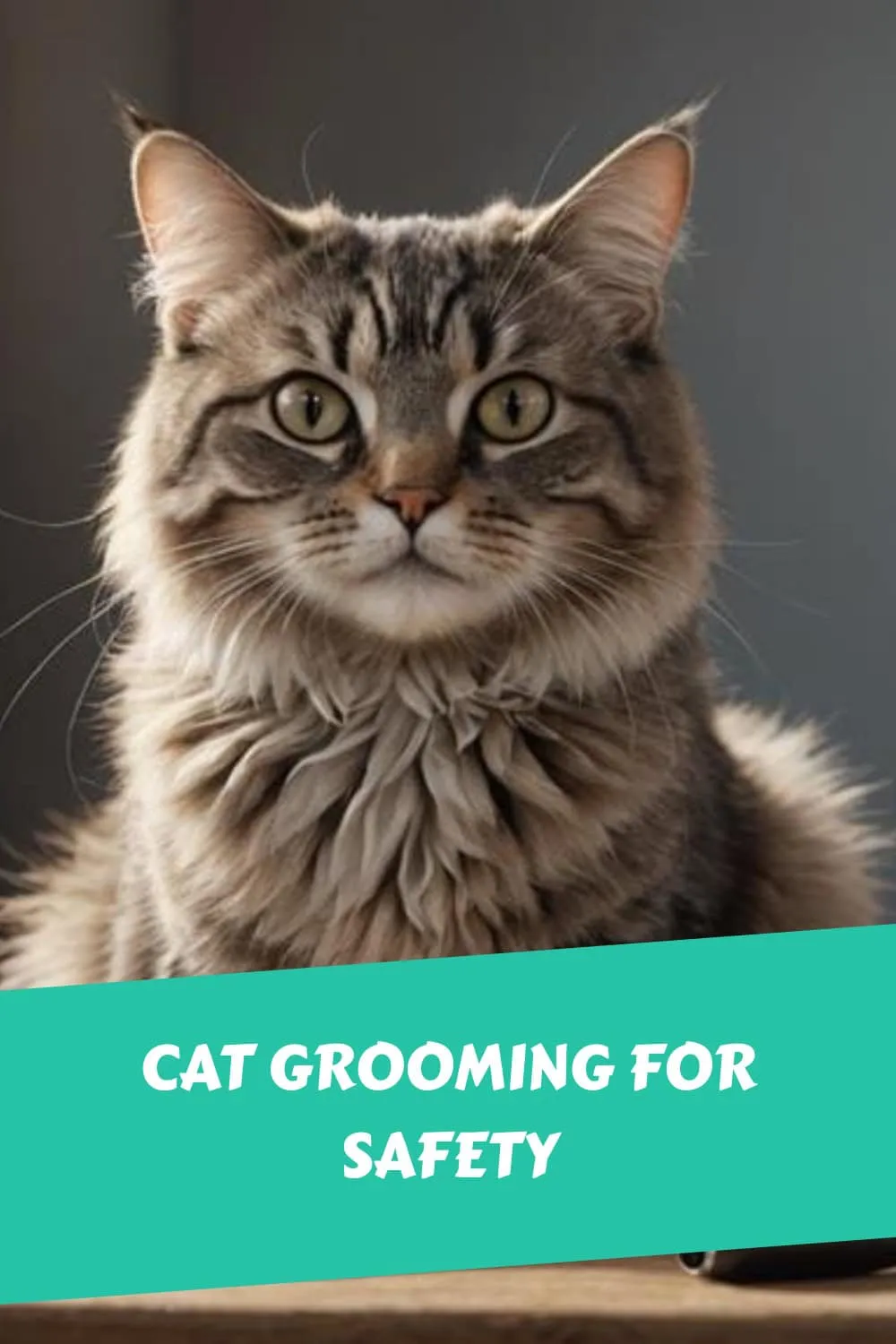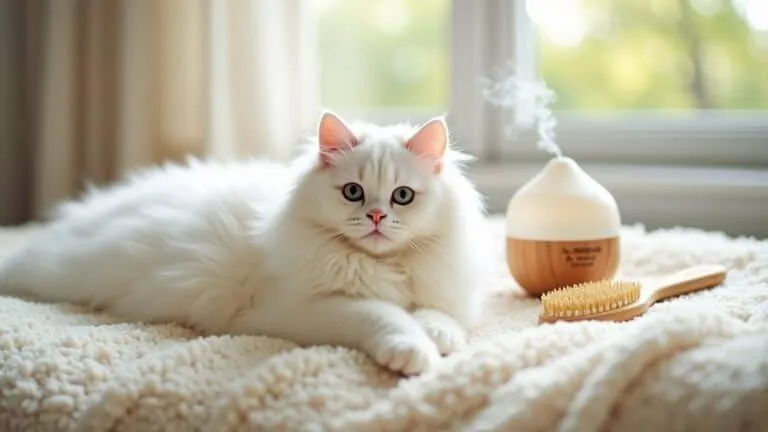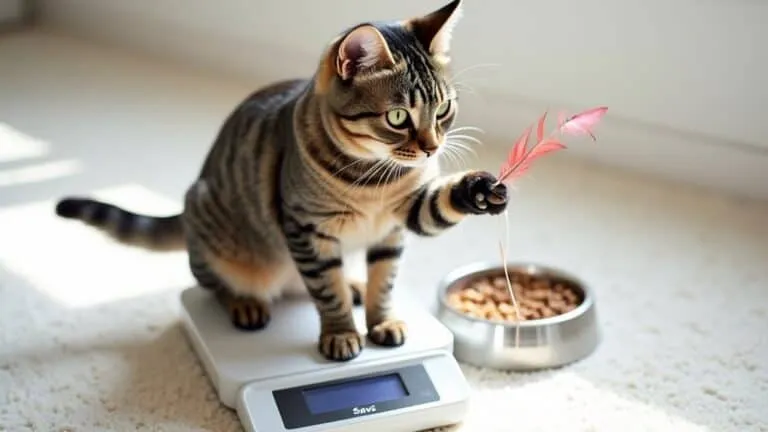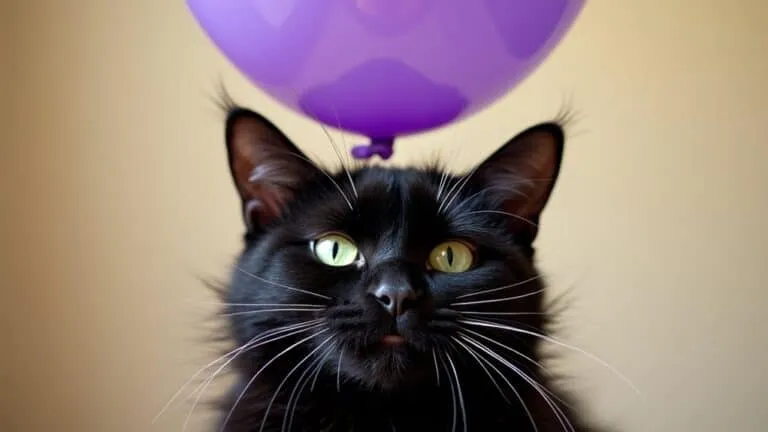The Best Fluffy Pancakes recipe you will fall in love with. Full of tips and tricks to help you make the best pancakes.
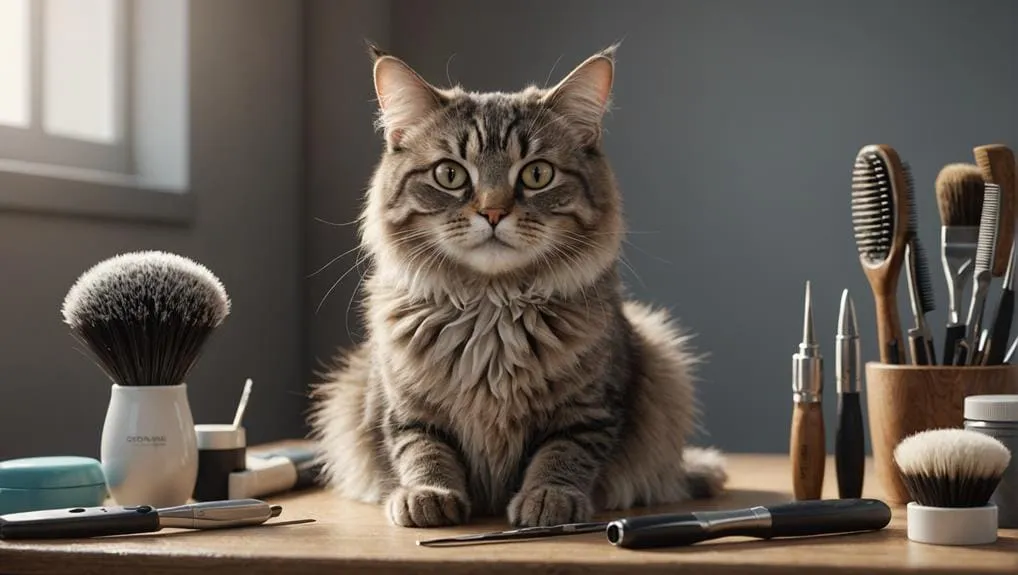
When it comes to cat grooming for safety, there are a few key things to keep in mind. First, you need to use the right techniques for your cat's specific needs. This means taking into account their behavior, health, and coat type.
For example, you'll want to use the right tools for your cat's coat type. This will help prevent skin issues and make the grooming process much smoother. Regular brushing is also essential, as it helps minimize shedding and matting.
But it's not just about the tools you use – it's also about how you handle your cat. You'll want to move calmly and gently to avoid stressing them out. If you notice your cat is getting anxious, it's a good idea to adjust your technique on the fly.
As you're grooming your cat, keep an eye out for any signs of potential health issues. Monitor their behavior and skin condition, and you'll be able to catch any problems early on.
By following these guidelines, you can ensure your cat stays clean, comfortable, and safe during the grooming process.
Grooming Techniques and Safety
When it comes to grooming your cat, it's super important to use the right techniques and tools. This ensures a safe and stress-free experience for both you and your feline friend.
You need to pick tools that cater to your cat's specific needs. For instance, if your cat has long hair, you'll want to use a slicker brush. If your cat prefers a gentler approach, grooming gloves might be the way to go.
Regular brushing is a must – aim for twice a week. This helps minimize shedding and matting, which is vital for maintaining your cat's coat health and reducing the risk of skin issues.
During grooming sessions, it's essential to handle your cat calmly and gently. You should also use positive reinforcement methods like treats to foster trust and reduce anxiety in your cat.
Feline Behavior and Health Assessments
When you're evaluating your feline client's behavior and health, there are three key areas you'll want to focus on.
First, you'll want to gain some insight into their behavior.
Then, you'll need to check for health indicators through grooming.
Finally, you'll need to look out for any skin problem symptoms.
By understanding these factors, you'll be better equipped to identify potential issues.
This will allow you to tailor your grooming approach to meet the individual needs of each cat.
This way, you can guarantee a safe and comfortable experience for your feline clients.
Feline Behavior Insights
When you understand how cats behave, you can tailor your grooming approach to fit their individual personalities. This helps minimize stress and ensures a safe, enjoyable experience for both you and the cat.
As you work with cats, it's crucial to recognize that age-related issues, like arthritis in older cats, can significantly impact your approach. You should regularly communicate with cat owners about changes in their pet's behavior and health concerns. This helps you understand each cat's unique needs and creates a safer grooming environment.
Staying up-to-date on feline behavior allows you to adapt your techniques, reducing stress and discomfort during grooming sessions. By paying attention to a cat's body language and stress signals, you can decide if restraint is necessary and adjust your approach to ensure a positive experience.
Grooming Health Indicators
Regular grooming sessions are a great way to identify key health indicators in your cat's behavior and physiology. By paying attention to your cat's response during grooming, you can detect signs of discomfort or stress, which may signal underlying health concerns such as dental disease or arthritis in older cats.
One important thing to monitor is changes in behavior. If your cat's behavior changes during grooming, it could be a sign of an underlying health issue.
Another essential thing to look out for is skin irritation. If your cat is excessively scratching or has visible lesions, it could reflect a broader health problem.
Don't forget to perform a detailed ear check to make sure their ears are free of debris and odor. If you notice any abnormalities, address them promptly.
Lastly, observe your cat's fur condition. A healthy coat often indicates overall health, while dull or matted fur may suggest underlying issues.
Skin Problem Symptoms
When you're grooming your cat, pay attention to their skin. Subtle changes can reveal underlying skin problems that might be causing them discomfort or stress.
As you groom, keep an eye out for signs of skin issues, like excessive scratching, licking, or chewing around sensitive areas. Take note of any scabs, redness, bald patches, or round, scaly patches – these can indicate potential skin problems.
Abnormal rashes or drainage might signal skin infections or conditions, so it's essential to do a thorough examination before grooming. Regular check-ups can help identify allergies or external parasites like fleas and ear mites that might be making your cat uncomfortable during grooming.
Be aware of changes in skin condition or behavior, like increased sensitivity or grooming distress. This can guide your care strategies and treatments. Don't forget to pay particular attention to sensitive paw pads, as they can be prone to irritation.
Skin Health Management and Prevention
When it comes to skin health management and prevention for your cat, understanding the causes of skin issues is key. Poor nutrition and external parasites are two common culprits.
By taking some simple steps, you can significantly reduce the risk of skin problems. For example, regular brushing can help remove dirt and debris, while a balanced diet provides your cat with the nutrients they need for healthy skin. Keeping their living environment clean is also crucial.
If your cat does develop skin issues, it's essential to recognize the warning signs and seek veterinary care promptly. This ensures that any problems can be treated effectively.
Causes of Skin Issues
As you explore the world of cat grooming, understanding the causes of skin issues is crucial for your feline friend's health and wellbeing.
Skin issues in cats can arise from a multitude of factors.
External parasites, like fleas and ear mites, can cause skin irritation, leading to excessive scratching and potentially serious complications if left untreated. For instance, fleas can trigger intense itching, which may result in skin lesions and hair loss. Similarly, ear mites can cause inflammation and irritation in the ear canal, leading to scratching and head shaking.
Allergies can also be a major culprit when it comes to skin issues in cats. Allergic reactions to food, environmental factors, or even grooming products can manifest as skin issues, requiring adjustments to your cat's diet or grooming routine. For example, a food allergy may cause itchiness, redness, and hair loss, while an environmental allergy may lead to skin lesions and scratching.
As your cat ages, they may develop skin tumors, which can present as unexplained lumps or changes in skin texture. It's essential to have these checked out by a veterinarian to determine the best course of action.
Lastly, stress-induced behaviors can also lead to skin issues in cats. Excessive licking or other stress-related behaviors can result in hair loss and skin damage, highlighting the importance of a calm environment and understanding cat psychology during grooming.
Preventive Measures
So, now that we know what causes skin issues in cats, we can take steps to prevent them. One important thing you can do is brush your cat regularly. This helps prevent tangles and matting, and it also reduces shedding, which can contribute to skin problems.
A healthy diet is also crucial for good skin health. Make sure your cat is eating food that's rich in essential fatty acids, as this will help reduce the likelihood of allergic reactions.
Fleas can also cause skin irritations, so it's important to work with your vet to implement a flea-treatment program. And don't forget to keep your home clean! Regularly vacuum and disinfect surfaces to get rid of allergens and irritants that can harm your cat's skin.
When it comes to grooming products, choose ones that are hypoallergenic and natural. This will help eliminate the risk of skin allergies and discomfort caused by harsh chemicals.
Treatments for Problems
Addressing skin issues in your cat requires a combination of topical treatments, dietary adjustments, and veterinary care, depending on the underlying cause of the problem.
You need to identify the root cause of the skin issue to provide effective treatments.
So, what're the common treatments for skin problems in cats?
Topical treatments are a good starting point. You can use shampoos, sprays, or ointments to treat external parasites like fleas and ear mites, or to soothe skin irritations.
Dietary adjustments can also make a big difference. Managing allergies often involves switching to a hypoallergenic diet or adding supplements containing fatty acids to support skin health.
In some cases, you may need to seek veterinary care. Your vet can determine the best course of treatment, which may involve antibiotics or antifungal medications for infections.
Diagnostic and Veterinary Considerations
When your cat has skin issues, it's crucial to understand how your vet will diagnose and treat the problem. Regular grooming can help you catch skin issues early on, so it's essential to know what to look for.
Your vet might use a few different tests to figure out what's going on. They might do a tape test to check for parasites, examine your cat's hair under a microscope to identify potential problems, or take a bacterial culture to see if there's an infection. In some cases, they might need to do a skin biopsy to get a definitive diagnosis. They'll also likely do blood tests to check your cat's overall health and see if there are any underlying conditions contributing to the skin problems.
It's also important to know that certain cats are more prone to skin issues. For example, kittens are more likely to have skin problems because their immune systems are still developing. Older cats and those with weakened immune systems are also more susceptible. Different breeds can also have varying levels of sensitivity to skin problems, so it's helpful to know about your cat's specific breed when you're trying to diagnose the issue.
Effective Restraint and Support Methods
During grooming sessions, effective restraint and support methods are essential to control movement and minimize injury risk, ensuring a safe and stress-free experience for both cats and groomers.
As a groomer, it's vital to understand the importance of restraint techniques that prioritize the cat's comfort and well-being. When it comes to keeping your feline clients calm and secure, there are a few techniques you should know about.
First, there's the towel and air muzzle method. These provide a calming effect and safety for groomers, allowing you to control movement while minimizing injury risk.
The scruffing technique is another important one to master. When applied correctly, this method enables you to manage fractious cats while ensuring their body weight is always supported to prevent discomfort.
If you need to transport or calm an aggressive cat, using a carrier can be a big help. This is where understanding each cat's individual responses to various restraint techniques really comes into play.
Continuing Education for Groomers
Staying ahead of the curve in feline grooming is crucial to ensure the safest and most effective experience for your feline clients. The key to achieving this is through continuing education. By staying up-to-date on the latest techniques, tools, and research, you'll be able to adapt to various cat temperaments and health conditions, providing a positive grooming experience even for the most sensitive felines.
Let's take a look at how different types of education can benefit your feline grooming skills.
Workshops and certifications, like the NCGI, can validate your expertise and improve your confidence when handling unique grooming situations.
Studying feline behavior helps you recognize signs of stress, so you can tailor your approaches to minimize discomfort during grooming sessions.
Research on grooming practices and cat anatomy enables you to make informed decisions that enhance the safety and well-being of the cats in your care, which leads to improved cat care and owner satisfaction.
Communication training is also essential, as it helps you understand a pet's history and specific needs, allowing you to offer personalized grooming services and increase client trust.
Through continuous training, you'll develop not only your technical skills but also your soft skills, like communication with cat owners. This thorough approach will help you provide the safest and most effective experience for your feline clients, building trust and loyalty with their owners.
Creating a Safe Grooming Environment
Creating a safe and comfortable grooming space for your feline clients is crucial to reducing stress and accidents. This not only ensures a pleasant experience for the cats, but also allows you to provide a safe and efficient service.
When designing your grooming space, keep clutter to a minimum. Clutter can be a hazard and a distraction, causing stress for both cats and groomers. Instead, maintain a clean and organized space that promotes a sense of calm.
It's also essential to have safety equipment on hand, just in case. Make sure you have a first aid kit and a fire extinguisher nearby to address any emergencies that may arise.
Creating a calm atmosphere is vital to reducing feline anxiety. Use calming pheromones and keep the environment quiet to promote a more relaxed grooming experience. This will help your feline clients feel more at ease, making the grooming process smoother for both them and you.
Finally, regularly inspect and secure your grooming tools and equipment. This will prevent accidents and ensure you have quick access to what you need during grooming procedures.
Minimizing Injury and Stress in Cats
When it comes to grooming cats, it's crucial to understand their behavior and anatomy. This helps you tailor your approach to minimize the risk of injury and stress during grooming sessions.
Recognizing signs of stress or discomfort in your feline clients is vital. You'll need to adjust your techniques accordingly. This might mean using appropriate restraint methods, like towels and air muzzles, to ensure safety while allowing visibility and comfort for the cat.
Regular discussions with cat owners about their pets' behavioral changes and health conditions are also essential. This fosters better communication and enhances safety during grooming.
To further minimize stress and injury, maintain a calm and clean grooming environment. This should be free from sudden movements and loud noises. This will significantly reduce anxiety in cats and minimize the likelihood of aggressive reactions.
Frequently Asked Questions
How to Immobilize a Cat for Grooming?
So you want to immobilize your cat for grooming without causing them too much stress. The key is to use effective restraint techniques along with some calming strategies.
One way to do this is by using a towel wrap. This involves gently wrapping your cat in a towel to restrict their movement. Another method is gentle scruffing, which is when you hold the loose skin at the back of their neck. This can help calm them down.
It's also a good idea to introduce the sensation of a muzzle gradually. You can do this by starting with just the sight and smell of the muzzle, then gradually introducing it to their face. This helps your cat get used to the feeling without getting overwhelmed.
How Do You Groom a Cat Safely?
When you groom your cat, you want to do it safely and correctly. To do that, you need to choose the right tools for their coat type. This is key to getting the benefits of grooming, like less shedding and better health. But it's just as important to make sure the experience is stress-free and safe for your cat.
Is It Safe for My Cat to Groom Me?
So you're wondering if it's safe for your cat to groom you?
In general, it can be. Mutual grooming has some great benefits. For one, it can help strengthen the bond between you and your cat. But understanding your cat's behavior is key to making sure it's a safe and enjoyable experience for both of you.
Is It OK to Take Cat to Groomer?
So you're thinking of taking your cat to a groomer? That's a great idea! Grooming can be super beneficial for your cat's health and wellbeing. For one, it can really reduce shedding, which is a huge plus if you're tired of finding cat hair everywhere. It can also improve your cat's skin health, which is important for their overall health.
But before you take your cat to a groomer, you need to make sure you choose someone who is gentle and understanding. Cats can get really anxious about grooming, so it's crucial to find someone who can make the experience as safe and stress-free as possible. With the right groomer, your cat will come out looking and feeling great!
Final Thoughts
As a groomer, you know that cat grooming for safety is about more than just making them look good. It's about making sure they feel comfortable and safe throughout the process.
Mastering gentle techniques is key. You need to know how to handle cats without scaring or hurting them.
Recognizing behavioral cues is also crucial. If you can tell when a cat is getting stressed or anxious, you can take steps to calm them down.
Monitoring skin health is another important aspect of cat grooming for safety. You need to be able to spot any potential health issues, like skin infections or irritations, and know how to deal with them.
Staying updated on the latest diagnostic considerations and veterinary protocols is vital too. This will ensure you're always using the best and safest methods when grooming cats.
By creating a secure and comfortable environment, you can minimize the risk of injury and stress. This means using the right equipment, having a calm and peaceful space, and being gentle and patient.
If you can get all of this right, you'll provide a positive grooming experience that benefits both you and the cat. It's a win-win!

